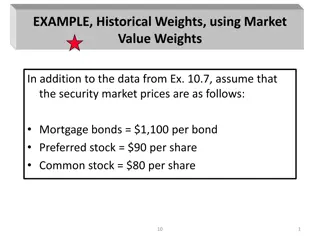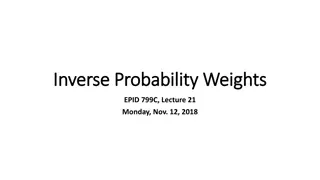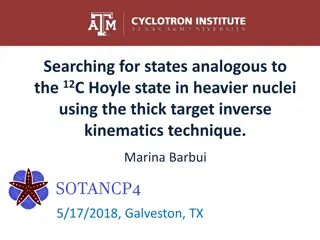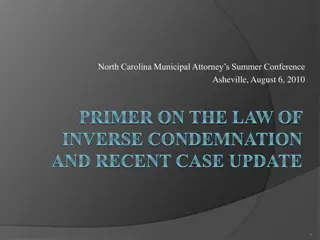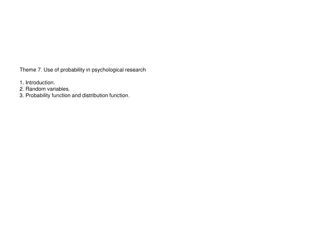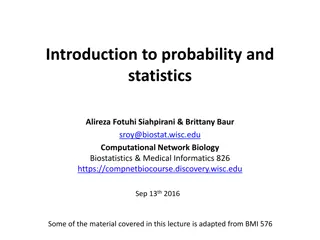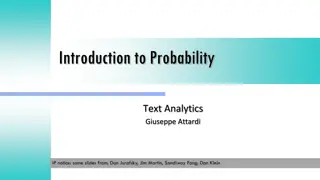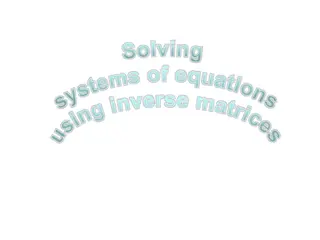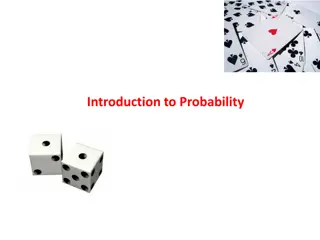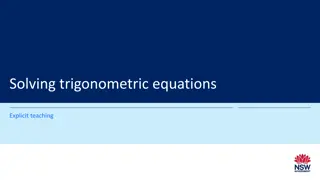Constructing Inverse Probability Weights for Dynamic Interventions
Lauren Cain, Principal Statistician at Takeda Pharmaceuticals, presents a case study on determining the optimal CD4 cell count to initiate antiretroviral therapy. The presentation covers clinical guidelines, treatment strategies, examples of dynamic interventions, and more. Attendees will engage in guided exercises using SAS software and have an opportunity for Q&A.
Download Presentation

Please find below an Image/Link to download the presentation.
The content on the website is provided AS IS for your information and personal use only. It may not be sold, licensed, or shared on other websites without obtaining consent from the author.If you encounter any issues during the download, it is possible that the publisher has removed the file from their server.
You are allowed to download the files provided on this website for personal or commercial use, subject to the condition that they are used lawfully. All files are the property of their respective owners.
The content on the website is provided AS IS for your information and personal use only. It may not be sold, licensed, or shared on other websites without obtaining consent from the author.
E N D
Presentation Transcript
Constructing Inverse Probability Weights for Dynamic Interventions When to Start Antiretroviral Therapy CIMPOD 2017 Lauren Cain Principal Statistician, Takeda Pharmaceuticals Visiting Scientist, Harvard T.H. Chan School of Public Health
Outline for today 1. Introduction to the Case-Study 2. Guided Exercises with Example Data (Using SAS) 3. Q&A 27 February 2017 When to Start
1. Introduction to the Case-Study
Motivating question What is the optimal CD4 cell count at which to initiate cART (combined antiretroviral therapy)? 27 February 2017 When to Start
Clinical guidelines At the time, clinical guidelines recommended initiating cART the first time CD4 cell count drops below 350 cells/mm3 (EACS 2009) 500 cells/mm3 (DHHS 2009) Examples of dynamic treatment strategies 27 February 2017 When to Start
Treatment strategies Static (non-dynamic) strategies: do not depend on time dependent covariates Dynamic strategies: depend on time dependent covariates 27 February 2017 When to Start
Examples of strategies: Initiate cART Static strategies at first visit after 3 months Dynamic strategies when CD4<500 when CD4<200 Rarely used in clinical practice Most RCTs Non optimal strategies Most common in clinical practice Rarely RCTs Optimal strategy is dynamic 27 February 2017 When to Start
Examples of strategies: Initiate cART after 3 months when CD4<500 id month CD4 cART id month CD4 cART 1 0 1 0 1 1 1 1 1 2 1 2 1 3 1 3 1 4 1 4 1 5 1 5 1 6 1 6 Strategy assigned at baseline Strategy assigned at baseline 27 February 2017 When to Start
Examples of strategies: Initiate cART after 3 months when CD4<500 id month CD4 cART id month CD4 cART 1 0 ? 0 1 0 ? ? 1 1 ? 0 1 1 ? ? 1 2 ? 0 1 2 ? ? 1 3 ? 1 1 3 ? ? 1 4 ? 1 1 4 ? ? 1 5 ? 1 1 5 ? ? 1 6 ? 1 1 6 ? ? Strategy assigned at baseline Treatment given known at baseline Strategy assigned at baseline Treatment given not known at baseline 27 February 2017 When to Start
Examples of strategies: Initiate cART after 3 months when CD4<500 id month CD4 cART id month CD4 cART 1 0 600 0 1 0 600 0 1 1 580 0 1 1 580 0 1 2 560 0 1 2 560 0 1 3 540 1 1 3 540 0 1 4 520 1 1 4 520 0 1 5 500 1 1 5 500 0 1 6 480 1 1 6 480 1 Strategy assigned at baseline Treatment given known at baseline Treatment does not depend on time-varying CD4 Strategy assigned at baseline Treatment given not known at baseline Treatment depends on time- varying CD4 27 February 2017 When to Start
Methods Paper Subset of HIV-CAUSAL Collaboration How to use IPW to compare dynamic strategies with grace periods 27 February 2017 When to Start
Clinical paper Complete HIV- CAUSAL Collaboration (at the time) Used inverse probability weighting methods to compare dynamic strategies AIDS or death: 500 better than 450 Death alone: similar for 300-500 27 February 2017 When to Start
The HIV-CAUSAL Collaboration: Contributing cohorts France: FHDH, PRIMO, SEROCO Spain: PISCIS, CoRIS, CoRIS MD, GEMES UK: UK CHIC, UK Register of Seroconverters Netherlands: ATHENA Switzerland: SHCS United States: VACS-VC Greece: AMACS Canada: South Alberta HIV Cohort Brazil: IPEC 27 February 2017 When to Start
The HIV-CAUSAL Collaboration: Sample Size After initial exclusions ~70,000 individuals ~3 million person-months ~40,000 initiate cART during follow-up ~2,800 deaths ~6,400 AIDS-defining illnesses or deaths 27 February 2017 When to Start
The HIV-CAUSAL Collaboration: Baseline covariates Sex Age Race (white, black, other or unknown) Geographic origin (Western developed countries, other or unknown) Mode of transmission (heterosexual, homosexual/bisexual, injection drug use, other or unknown) CD4 cell count HIV-1 RNA Calendar year Years since HIV diagnosis Cohort 27 February 2017 When to Start
The HIV-CAUSAL Collaboration: Time-varying covariates CD4 cell count HIV-1 RNA Time since last laboratory measurement AIDS-defining illness (when outcome is death) 27 February 2017 When to Start
Finding the optimal strategy: Compare 31 strategies Initiate cART within m months after the recorded CD4 first drops below x cells/mm3 x takes the values 200 to 500 in increments of 10 Illustrate using m = 0, 3 Exercise and main analysis uses m = 6 Optimal strategy = highest AIDS-free survival after 5 years 27 February 2017 When to Start
Preferred method: Randomized clinical trial (RCT) Identify eligible individuals HIV-positive, AIDS-free, cART-na ve First time CD4 in the range 200-500 cells/mm3 Randomly assign each eligible individual to one of the 31 strategies Follow until AIDS, death or administrative end of follow-up 27 February 2017 When to Start
Alternative method: Emulate a RCT Use observational data Identify eligible individuals & observations HIV-positive, AIDS-free, cART-na ve First time CD4 in the range 200-500 cells/mm3 Determine which of the 31 regimes they are following Assign them to follow those regimes Artificially censor them if and when they deviate Follow until AIDS, death, censoring, or administrative end of follow-up 27 February 2017 When to Start
Need for causal inference methods Traditional methods cannot appropriately adjust for time-varying confounders affected by prior exposure CD4 cell count affects decision to initiate Initiation affects future values of CD4 cell count The comparison of dynamic strategies requires novel statistical methods designed specifically for dynamic strategies and time-varying confounding 27 February 2017 When to Start
2. Guided Exercises with Example Data (Using SAS)
Example Data Simulated data set based on the HIV-CAUSAL Collaboration Using a random sample of eligible individuals from that data set 27 February 2017 When to Start
Simulated v. real data No losses to follow up One lab measurement per month Temporal order of variables within month known Lab measurements Treatment Censoring Outcome 27 February 2017 When to Start
Pre-Processing of Data Identify eligible individuals & observations Found baseline and set it to month = 0 Removed ineligible individuals and observations AIDS or death as the event 28 February 2017 When to Monitor
Getting Started Open the program: analysis_wts.sas Read in the data set: wts_aidsdeath.sas7bdat Look carefully at the data 27 February 2017 When to Start
Step 0: Create an eligibility variable for use in the weight models Categorize several continuous variables 27 February 2017 When to Start
Step 1: Fit a model for treatment using proc logistic Merge the output of the proc logistic with the original data set 27 February 2017 When to Start
Step 2: Create up to 7 replicates of each individual 27 February 2017 When to Start
Step 2: Why are we creating replicates? Almost all individuals have data that are consistent with more than one strategy 1. Randomly allocate an individual to one of the strategies he follows 2. Assign individuals to follow more than one strategy 27 February 2017 When to Start
Step 2: Replicates Make replicates (clones) of the individual # replicates = # strategies followed when CD4 first drops below 500 cells/mm3 ID1:CD40=462, cART0=1 4 replicates (m 0) ID2: CD40=451, cART0=0 26 replicates (m = 0) 31 replicates (m > 0) 27 February 2017 When to Start
Step 3: Censor replicates when they deviate from their assigned strategy Identify the month in which the strategy-specific CD4 threshold is crossed Recenter and rescale the regime variable Count the replicates and events for each strategy 27 February 2017 When to Start
Step 3: Reasons for censoring: Initiating cART too soon Not initiating cART soon enough Note: Censoring is a function of Treatment A subset of the prognostic factors (i.e., CD4 cell count) 27 February 2017 When to Start
Step 3: Observations ineligible for censoring m = 0 m > 0 At-1=1 During month 0 At-1=1 During 1st m months if regime > CD40 For m months after CD4 first drops below x 27 February 2017 When to Start
Sample data: ID 1 id month CD4 cART regimes followed m = 0 m = 3 1 0 462 1 4 (470-500) 4 (470-500) 1 1 462 1 4 (470-500) 4 (470-500) 1 2 378 1 4 (470-500) 4 (470-500) 27 February 2017 When to Start
Sample data: ID 2 id month CD4 cART regimes followed m = 0 m = 3 2 0 451 0 26 (200-450) 31 (200-500) 2 1 451 0 26 (200-450) 31 (200-500) 2 2 417 0 22 (200-410) 31 (200-500) 2 3 336 1 8 (340-410) 17 (340-500) 2 4 336 1 8 (340-410) 17 (340-500) 27 February 2017 When to Start
Sample data: ID 1 (m = 0) id month CD4 cART regimes followed regimes censored 1 0 462 1 4 (470-500) 0 1 1 462 1 4 (470-500) 0 1 2 378 1 4 (470-500) 0 27 February 2017 When to Start
Expanded data: ID 1 (m = 0) id month CD4 cART regime censor 1 0 462 1 500 0 Replicate #1: Regime = 500 1 1 462 1 500 0 1 2 378 1 500 0 1 0 462 1 490 0 Replicate #2: Regime = 490 1 1 462 1 490 0 1 2 378 1 490 0 1 0 462 1 480 0 Replicate #3: Regime = 480 1 1 462 1 480 0 1 2 378 1 480 0 1 0 462 1 470 0 Replicate #4: Regime = 470 1 1 462 1 470 0 1 2 378 1 470 0 27 February 2017 When to Start
Sample data: ID 2 (m = 0) id month CD4 cART regimes followed regimes censored 2 0 451 0 26 (200-450) 0 2 1 451 0 26 (200-450) 0 2 2 417 0 22 (200-410) 4 (420-450) 2 3 336 1 8 (340-410) 14 (200-330) 2 4 336 1 8 (340-410) 0 27 February 2017 When to Start
Expanded data: ID 2 (m = 0) id month CD4 cART regime censor 2 0 451 0 450 0 Replicates #1-4: Regime = 420-450 2 1 451 0 450 0 2 2 417 0 450 1 2 0 451 0 350 0 2 1 451 0 350 0 Replicates #5-12: Regime = 340-410 2 2 417 0 350 0 2 3 336 1 350 0 2 4 336 1 350 0 2 0 451 0 250 0 2 1 451 0 250 0 Replicates #13-26: Regime = 200-330 2 2 417 0 250 0 2 3 336 1 250 1 27 February 2017 When to Start
Step 4: Build the unstabilized IP weights Truncate the weights 27 February 2017 When to Start
Step 4: Why are we building IP weights? Censoring may introduce time- dependent selection bias Weight by the inverse probability of remaining uncensored 27 February 2017 When to Start
Step 4: Weights for treatment or for censoring? Recall: Censoring is a function of Treatment CD4 cell count Conditional probability of remaining uncensored = Conditional probability of not initiating treatment (before the grace period) = Conditional probability of initiating treatment (end of the grace period) 27 February 2017 When to Start
Step 4: Adjusting for time-varying selection bias Use IP weighting to create a pseudo-population in which treatment is independent of measured past prognostic factors In the pseudo-population, the artificial censoring is noninformative Under the assumptions of conditional exchangeability, positivity, and consistency 27 February 2017 When to Start
Step 4: IP weights Use a parametric model (e.g., logistic) to estimate the conditional probability of treatment given past history at each time = = 1 ,D t if A = 0 t 1 f(A | A 0,L ) W k 1 1 otherwise = k k 1 k k t t = 0,1, At Lt Dt At Lt time measured in months since baseline indicator for treatment use at time t vector of covariates measured at time t indicator for developing the event at time t history of treatment through time t history of covariates through time t 27 February 2017 When to Start
Estimating the IP weights: ID 1 id (i) month (t) cART (At) 1 CD4 1 0 462 1 1 462 1 1 2 378 1 27 February 2017 When to Start
Estimating the IP weights: ID 1 (m = 0) id (i) month (t) cART (At) 1 regime (X) censor (Ct) 0 Pr(C = = 0|C = = 0,D = = 0,X = = x,L = = t l ,A = = a ) CD4 t t 1 t t t 1 t 1 1 0 462 500 . 1 1 462 1 500 0 1 1 2 378 1 500 0 1 1 0 462 1 490 0 . 1 1 462 1 490 0 1 1 2 378 1 490 0 1 1 0 462 1 480 0 . 1 1 462 1 480 0 1 1 2 378 1 480 0 1 1 0 462 1 470 0 . 1 1 462 1 470 0 1 1 2 378 1 470 0 1 27 February 2017 When to Start
Estimating the IP weights: ID 1 (m = 3) id (i) month (t) cART (At) 1 regime (X) censor (Ct) 0 Pr(C = = 0|C = = 0,D = = 0,X = = x,L = = t l ,A = = a ) CD4 t t 1 t t t 1 t 1 1 0 462 500 . 1 1 462 1 500 0 1 1 2 378 1 500 0 1 1 0 462 1 490 0 . 1 1 462 1 490 0 1 1 2 378 1 490 0 1 1 0 462 1 480 0 . 1 1 462 1 480 0 1 1 2 378 1 480 0 1 1 0 462 1 470 0 . 1 1 462 1 470 0 1 1 2 378 1 470 0 1 27 February 2017 When to Start
Estimating the IP weights: ID 2 id (i) month (t) cART (At) 0 CD4 2 0 451 2 1 451 0 2 2 417 0 2 3 336 1 2 4 336 1 27 February 2017 When to Start
Estimating the IP weights: ID 2 (m = 0) id (i) month (t) cART (At) 0 regime (X) censor (Ct) 0 Pr(C = = 0|C = = 0,D = = 0,X = = x,L = = t l ,A = = a ) CD4 t t 1 t t t 1 t 1 2 0 451 450 . 2 1 451 0 450 0 1-p21* p22 . 2 2 417 0 450 1 2 0 451 0 350 0 2 1 451 0 350 0 1-p21 1-p22 p23 1 2 2 417 0 350 0 2 3 336 1 350 0 2 4 336 1 350 0 2 0 451 0 250 0 . 2 1 451 0 250 0 1-p21 1-p22 1-p23 2 2 417 0 250 0 2 3 336 1 250 1 p = Pr(A = 1| A = i,t 1 a ,D = 0,L = i,t l ) * it t t 1 t t 27 February 2017 When to Start
Estimating the IP weights: ID 2 (m = 3), part 1 id (i) (i) id month (t) (t) month cART (At) 0 0 cART (At) regime regime (X) (X) censor (Ct) 0 0 censor (Ct) Pr(C Pr(C = = = = 0|C 0|C = = = = 0,D 0,D = = = = 0,X 0,X = = = = x,L x,L = = = = t l ,A t l ,A = = = = a a ) ) CD4 CD4 t t t 1 t 1 t t t t t 1 t 1 t 1 t 1 2 2 0 0 451 451 480 480 . . 2 2 1 1 451 451 0 0 480 480 0 0 1 1 2 2 2 2 417 417 0 0 480 480 0 0 1 1 2 2 3 3 336 336 1 1 480 480 0 0 P23* P23* 1 1 2 2 4 4 336 336 1 1 480 480 0 0 2 2 0 0 451 451 0 0 450 450 0 0 . . 2 2 1 1 451 451 0 0 450 450 0 0 1-p21 1 1 1-p21 2 2 2 2 417 417 0 0 450 450 0 0 2 2 3 3 336 336 1 1 450 450 0 0 1 1 2 2 4 4 336 336 1 1 450 450 0 0 1 1 p = Pr(A = 1|A = i,t 1 a ,D = 0,L = i,t l ) * it t t 1 t t 27 February 2017 When to Start



